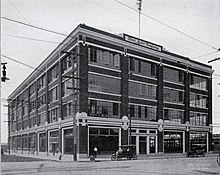Ford Motor Company - Columbus Assembly Plant

Beginning in 1914, Ford Model T automobiles were assembled at the Ford Motor Company Branch Assembly Plant located at 427 Cleveland Avenue, Columbus, Ohio. The components arrived by train and the automobiles were assembled at the plant for delivery to local dealers. The shipping boxes were sized so that the wood from the empty boxes could be used as floorboards for the automobiles. The plant was closed in 1939.[1]
The Columbus Assembly Plant was designed by Architect John Graham, a Seattle architect working in the Ford architecture department in Highland Park, Michigan. Graham was the designer of several branch plants, including plants in Seattle, Cambridge, Houston, Dallas, Columbus, Cincinnati, Atlanta, and Pittsburgh. Architect Albert Kahn was responsible for nearly all of the remaining 1920s generation of branch assembly plants.[2]
The building currently houses the Kroger Co. Columbus Bakery.[3]
Branch Assembly Plants
Ford Motor Company relied on a network of sales agencies-dealers which agreed to sell Model T cars, stock parts, and provide mechanics' services. Ford initially manufactured fully assembled cars in Detroit and then "knocked them down" (took off the wheels and otherwise prepared them for shipment) and shipped them to dealers. The agents in distant cities reassembled the knocked-down cars before sale. To better serve the network of sales dealerships. Ford took direct control of agencies in New York and Philadelphia in 1905 and the following year established company-owned branches in Boston, Buffalo, Cleveland, Chicago, St. Louis, and Kansas City, initially in leased buildings. Ford branches also sold Ford cars in addition to assembling vehicles for delivery to dealerships. Ford sold over 200,000 autos in 1914, with 80 percent of sales originating from the company's twenty-nine branches. As Ford sales continued to increase, the company built additional branch assembly plants in company-owned buildings, most of which were designed by Architect Albert Kahn.[4]
The Ford system of branch plants was so successful that the company's competitors soon adopted the practice. Chevrolet, for example, established four branch assembly plants in 1915-1916 throughout the United States.[5] Ford Branch Assembly Plants were located in Atlanta, Buffalo, Cambridge, Chicago, Cincinnati, Cleveland, Columbus, Dallas, Denver, Detroit, Fargo, Houston, Indianapolis, Kansas City, Long Island City, Los Angeles, Louisville, Memphis, Milwaukee, Minneapolis, Oklahoma City, Omaha, Philadelphia, Pittsburgh, Portland, Ore., San Francisco, Seattle and St. Louis.[6]
See also
References
- ^ "Columbus, Ohio: 1898-1950 in Vintage Postcards", Barrett, Richard E., Page 123
- ^ "Ford Richmond Assembly Plant - Architect Albert Kahn", fordmotorhistory.com
- ^ "Kroger Manufacturing Locations", Kroger Manufacturing Division
- ^ "Ford's System of Branch Assembly Plants", fordmotorhistory.com
- ^ "Ford's System of Branch Assembly Plants", fordmotorhistory.com
- ^ "Ford Factory Facts", Ford Motor Company (1915), Model T Ford Club of America
External links
- Ford Motor Company - Columbus Assembly Plant, Plant Photograph (1915), Columbus Metropolitan Library Digital Collection
- Ford Factory Facts Booklet, Ford Motor Company (1915), Model T Ford Club of America
- Google Street View from Cleveland Ave.
- Google Street View from Interstate 670

